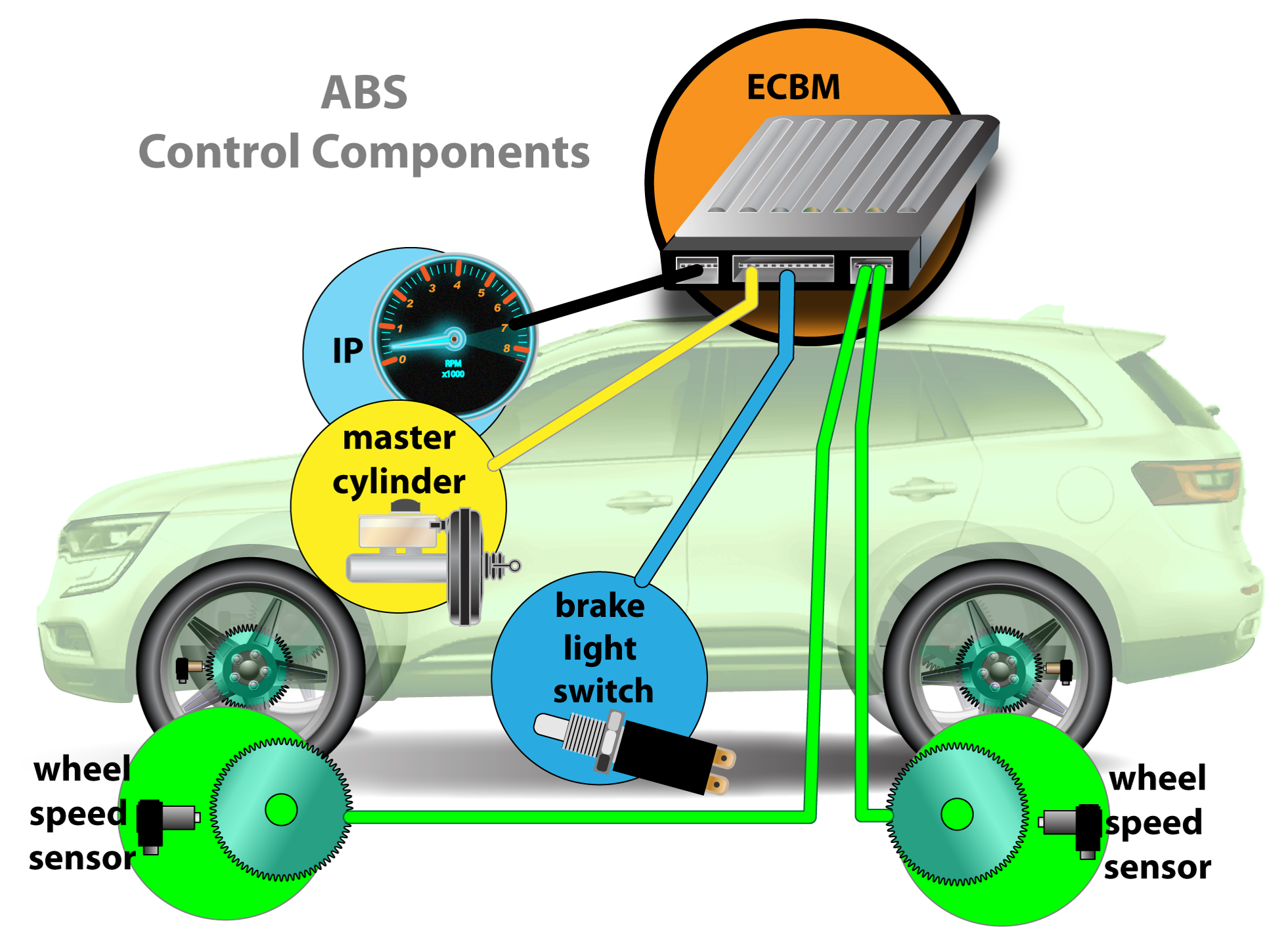Have you ever wondered how your car manages to stop so safely and effectively? Anti-lock Brake Systems (ABS) are the secret behind this incredible feat of engineering, and in this blog post, we will unlock their secrets, empowering you with the knowledge to drive with confidence.
Unveiling the Pain Points of Braking
Before we delve into ABS, let’s explore some common frustrations associated with braking. Imagine navigating slick roads, where braking causes your tires to lock and slide. This loss of control can be nerve-wracking, potentially leading to accidents. Additionally, aggressive braking can result in premature wear and tear on your tires, adding to your maintenance expenses.
The Antidote: Anti-lock Brake Systems
ABS revolutionizes braking by preventing wheel lock-up. It achieves this through a sophisticated interplay of sensors, valves, and a controller. When sensors detect impending wheel lock, the controller rapidly modulates brake pressure, allowing the wheels to maintain traction with the road surface. This prevents uncontrolled sliding and maintains steering control, significantly enhancing driving safety.
ABS: A Comprehensive Overview
At the heart of ABS lies a series of sensors that continuously monitor wheel speed. When a wheel’s speed drops abruptly, indicating potential lock-up, the ABS controller intervenes. It adjusts brake pressure to that particular wheel, preventing it from locking and allowing it to maintain grip. This process occurs repeatedly, enabling the vehicle to slow down safely while maintaining control.

Unveiling the History and Myths of ABS
ABS has a rich history, with its roots in the aviation industry. In the 1950s, aircraft manufacturers developed anti-skid systems to prevent wheel lock-up during landing. This technology eventually found its way into automobiles, revolutionizing road safety. Over the years, ABS has evolved significantly, shedding misconceptions and proving its effectiveness in a wide range of driving conditions.
![]()
Harnessing the Hidden Secrets of ABS
ABS offers a myriad of benefits that enhance driving. It provides exceptional control during emergency braking, allowing you to maintain steering ability and avoid obstacles. ABS also reduces braking distance on both wet and dry surfaces, significantly increasing safety. Additionally, it optimizes tire usage, minimizing wear and extending their lifespan.

Expert Recommendations for ABS Maintenance
As with any automotive system, proper maintenance is crucial for optimal performance of ABS. Regular brake inspections and fluid changes are essential. Additionally, ensuring the ABS sensors and wiring are clean and undamaged is vital. If you encounter any ABS-related issues, don’t hesitate to consult with a qualified mechanic for prompt resolution.

ABS in Detail: A Comprehensive Guide
ABS components work seamlessly to deliver enhanced braking capabilities. The wheel speed sensors monitor and transmit data to the ABS controller, which then modulates brake pressure through hydraulic valves. This intricate system ensures precise and rapid adjustment of brake force, preventing wheel lock-up. Moreover, ABS is designed to be fail-safe; if a sensor malfunctions, the system defaults to a conventional braking mode.

Tips for Maximizing ABS Performance
To leverage the full potential of ABS, consider these tips. Avoid sudden and hard braking, as this can trigger ABS prematurely. Instead, apply steady and firm pressure on the brake pedal, allowing the system to modulate brake force effectively. Additionally, be aware that ABS may extend braking distances on loose surfaces such as gravel or snow. Adjust your driving accordingly to ensure safety in all conditions.

ABS Technology: Past, Present, and Future
ABS has come a long way since its inception, evolving with technological advancements. Modern ABS systems incorporate advanced algorithms and electronics, providing even finer control over braking. As technology continues to progress, we can expect further enhancements in ABS capabilities, further bolstering driving safety. Keep up-to-date with the latest developments to reap the benefits of cutting-edge ABS technology.

Fun Facts about ABS
ABS is not just about safety; it’s also fascinating! Did you know that ABS can generate a rhythmic pulsing sensation in the brake pedal during operation? This is perfectly normal and indicates that the system is working as intended. Additionally, ABS can help reduce stopping distances in both wet and dry conditions, making it a valuable safety feature regardless of the weather.

Troubleshooting ABS: Common Issues and Solutions
While ABS is a reliable system, occasional issues may arise. If you notice the ABS warning light illuminated on your dashboard, it indicates a potential problem. Common causes include faulty wheel speed sensors, malfunctioning hydraulic valves, or electrical issues. Consult a qualified mechanic to diagnose and resolve the issue promptly, ensuring optimal ABS performance and driving safety.

ABS: What if it Fails?
Modern vehicles are equipped with failsafe mechanisms for ABS. In the event of system failure, the vehicle will revert to a conventional braking mode, albeit without ABS assistance. This allows you to maintain control of your vehicle and bring it to a stop, albeit with reduced braking efficiency. It is important to seek professional repair as soon as possible to restore full ABS functionality.
/7851256906_ecfe040320_o-56a056445f9b58eba4afef9f.jpg)
ABS: A Vital Safety Feature
ABS is a crucial safety feature that has revolutionized driving. It enhances control during emergency braking, reduces braking distances, and extends tire life. By understanding the secrets of ABS and its benefits, you can drive with confidence, knowing that your vehicle is equipped with advanced technology that safeguards your safety and well-being.
FAQs about ABS
1. What is ABS and how does it work?
ABS is an Anti-lock Brake System that prevents wheels from locking during braking, allowing for greater control and stability. It uses sensors and a controller to modulate brake pressure, preventing skidding.
2. What are the benefits of ABS?
ABS reduces braking distances, increases control during emergency braking, and extends tire life. It is particularly beneficial in slippery conditions or when driving on loose surfaces.
3. How do I know if my car has ABS?
Most modern vehicles are equipped with ABS. Check your owner’s manual or look for the ABS warning light on your dashboard, typically denoted by the letters “ABS” or an image of a car with skid marks.
4. What should I do if my ABS warning light is on?
If the ABS warning light is illuminated, it indicates a potential issue with the ABS system. It is advisable to consult a qualified mechanic to diagnose and resolve the problem to ensure full ABS functionality.
Conclusion of Unlocking The Secrets Of Antilock Brake Systems
Anti-lock Brake Systems (ABS) are an indispensable safety feature that has transformed driving, enhancing control, reducing braking distances, and extending tire life. By unlocking the secrets of ABS, you gain a deeper appreciation for this technological marvel. Embrace the knowledge and drive with confidence, knowing that you have a safety net that works tirelessly to protect you and your loved ones on the road.
